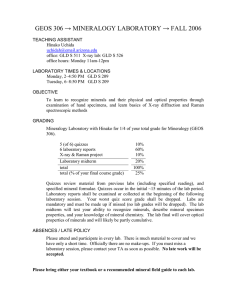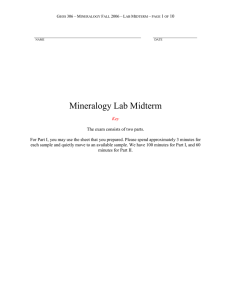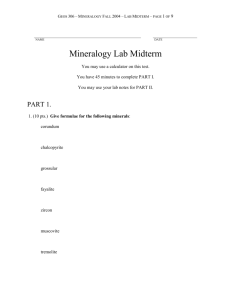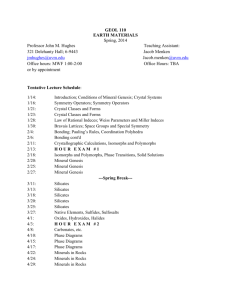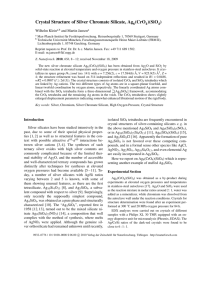Midterm study guide
advertisement
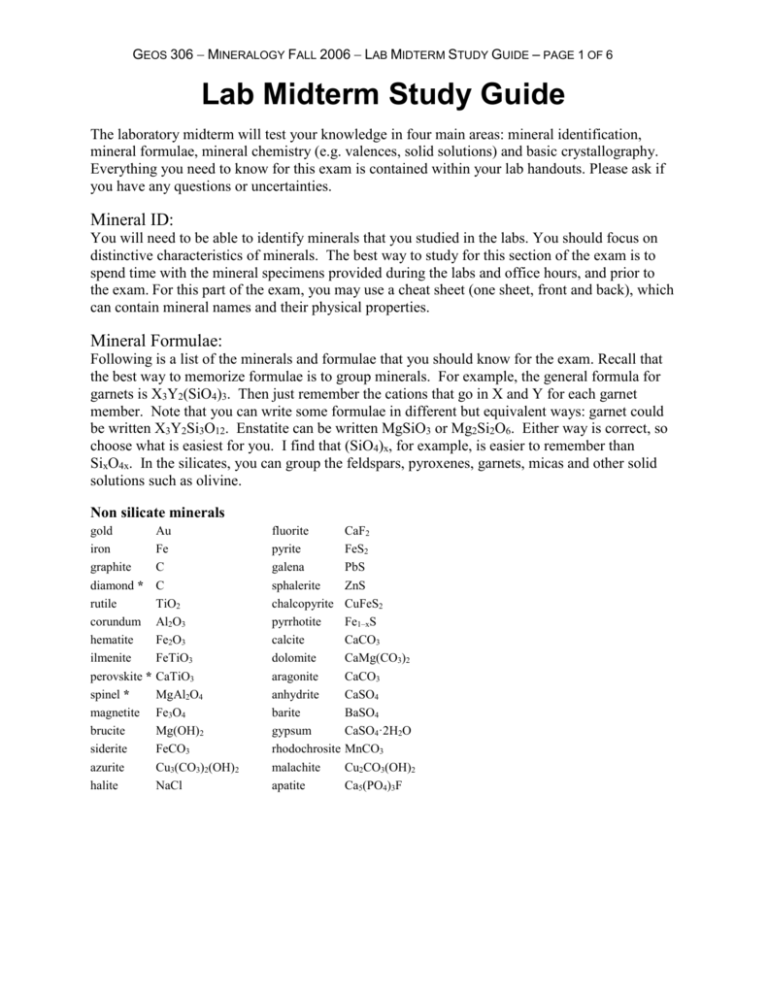
GEOS 306 MINERALOGY FALL 2006 LAB MIDTERM STUDY GUIDE – PAGE 1 OF 6 Lab Midterm Study Guide The laboratory midterm will test your knowledge in four main areas: mineral identification, mineral formulae, mineral chemistry (e.g. valences, solid solutions) and basic crystallography. Everything you need to know for this exam is contained within your lab handouts. Please ask if you have any questions or uncertainties. Mineral ID: You will need to be able to identify minerals that you studied in the labs. You should focus on distinctive characteristics of minerals. The best way to study for this section of the exam is to spend time with the mineral specimens provided during the labs and office hours, and prior to the exam. For this part of the exam, you may use a cheat sheet (one sheet, front and back), which can contain mineral names and their physical properties. Mineral Formulae: Following is a list of the minerals and formulae that you should know for the exam. Recall that the best way to memorize formulae is to group minerals. For example, the general formula for garnets is X3Y2(SiO4)3. Then just remember the cations that go in X and Y for each garnet member. Note that you can write some formulae in different but equivalent ways: garnet could be written X3Y2Si3O12. Enstatite can be written MgSiO3 or Mg2Si2O6. Either way is correct, so choose what is easiest for you. I find that (SiO4)x, for example, is easier to remember than SixO4x. In the silicates, you can group the feldspars, pyroxenes, garnets, micas and other solid solutions such as olivine. Non silicate minerals gold iron graphite diamond * rutile corundum hematite ilmenite perovskite * spinel * magnetite brucite siderite azurite halite Au Fe C C TiO2 Al2O3 Fe2O3 FeTiO3 CaTiO3 MgAl2O4 Fe3O4 Mg(OH)2 FeCO3 Cu3(CO3)2(OH)2 NaCl fluorite pyrite galena sphalerite chalcopyrite pyrrhotite calcite dolomite aragonite anhydrite barite gypsum rhodochrosite malachite apatite CaF2 FeS2 PbS ZnS CuFeS2 Fe1–xS CaCO3 CaMg(CO3)2 CaCO3 CaSO4 BaSO4 CaSO4·2H2O MnCO3 Cu2CO3(OH)2 Ca5(PO4)3F GEOS 306 MINERALOGY FALL 2006 LAB MIDTERM STUDY GUIDE – PAGE 2 OF 6 Silicate minerals quartz (including rock crystal, milky quartz, smoky quartz, amethyst, citrine, rose quartz, chalcedony, agate, chert, jasper, and petrified wood) K-feldspar (microcline, orthoclase, and orthoclase) albite (plagioclase series) anorthite (plagioclase series) nepheline serpentine (antigorite, chrysotile) kaolinite talc pyrophyllite annite (biotite series) phlogopite (biotite series) muscovite actinolite tremolite diopside hedenbergite enstatite ferrosilite jadeite spodumene aegerine wollastonite almandine grossular andradite pyrope spessartine forsterite (olivine series) fayalite (olivine series) kyanite – andalusite - sillimanite zircon beryl titanite topaz SiO2 KAlSi3O8 NaAlSi3O8 CaAl2Si2O8 (Na,K)AlSiO4 Mg3Si2O5(OH)4 Al2Si2O5(OH)4 Mg3Si4O10(OH)2 Al2Si4O10(OH)2 KFe3(Si3Al)O10(OH)2 KMg3(Si3Al)O10(OH)2 KAl2(Si3Al)O10(OH)2 Ca2(Mg,Fe)5Si8O22(OH)2 Ca2Mg5Si8O22(OH)2 CaMgSi2O6 CaFeSi2O6 Mg2Si2O6 Fe2Si2O6 NaAlSi2O6 LiAlSi2O6 NaFeSi2O6 Ca2Si2O6 Fe3Al2(SiO4)3 Ca3Al2(SiO4)3 Ca3Fe2(SiO4)3 Mg3Al2(SiO4)3 Mn3Al2(SiO4)3 Mg2SiO4 Fe2SiO4 Al2SiO5 ZrSiO4 Be3Al2Si6O18 CaTiSiO5 Al2SiO4(F,OH)2 Mineral Chemistry: Revisit the following topics from your labs: feldspar ternary diagram (see exercises below) isomorphs (minerals with the same crystal structure, but different chemical compositions) olivine solid solution series (forsterite-fayalite) simple substitution (of cations) coupled substitution (of cations) GEOS 306 MINERALOGY FALL 2006 LAB MIDTERM STUDY GUIDE – PAGE 3 OF 6 determination of valences single chain silicate valences pyroxene group ternary diagram (be able to draw it, see exercises below) Mohs hardness scale Review your quizzes. Basic Crystallography and Symmetry: Be sure you know the names of the six crystal systems, and the definitions of their unit cells. Remember that a unit cell is defined by six values: the lengths of three non-parallel sides (a,b,c) and the angles between the sides (α,β,γ). Be familiar with mirror planes, rotational axes (2-, 3-, 4- and 6-fold), and inversion centers. Be able to identify the symmetry elements and crystal system of plaster models. Especially important are the key symmetry elements of each system (e.g., cubic forms exhibit four 3-fold rotational axes). GEOS 306 MINERALOGY FALL 2006 LAB MIDTERM STUDY GUIDE – PAGE 4 OF 6 Sample Questions: 1. Write general formulas for the following mineral groups. (Use symbols for cations). Sulfates: Carbonates: Micas: Garnets: Pyroxenes: K-spars: Plagioclase: 2. Fill in the feldspar ternary diagram. Be as detailed as you wish, but at least label the three “end members” with mineral names and compositions. GEOS 306 MINERALOGY FALL 2006 LAB MIDTERM STUDY GUIDE – PAGE 5 OF 6 3. Give an example, using mineral formulae, of simple substitution. 4. Give an example, using mineral formulae, of coupled substitution. 5. Fill in the pyroxene ternary diagram. Be as detailed as you wish, but at least label the three “end members” with mineral names and compositions. 6. List the symmetry (mirror planes and rotational symmetry) of the following 2-D shapes: Rotational: Mirrors: GEOS 306 MINERALOGY FALL 2006 LAB MIDTERM STUDY GUIDE – PAGE 6 OF 6 Rotational: Mirrors: Rotational: Mirrors:
